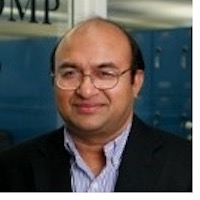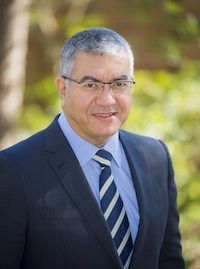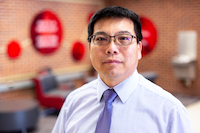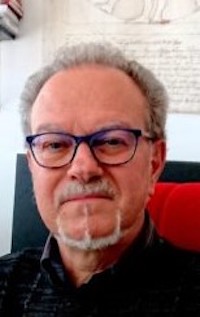IEEE Services 2022 Plenary Panel:
Technology, Innovation & Partnership - from Lab to Home
Plenary Panel: Technology, Innovation & Partnership - from Lab to Home
Date/Time: Wednesday July 13
17:00-18:00 CET (Barcelona)
According to the National Science Foundation (NSF), to enter into the TIP (Technology, Innovation, and Partnerships) program, a concept (for example, from Lab to Home) should develop breakthrough technologies, address social and economic demands, lead to new, high-wage employment, and encourage all Americans to engage in the United States' research and innovation business. Under the concept of "Technology, Innovation & Partnership - from Lab to Home," we proposed our lab-invented technology as a product that can be transitioned from the research lab to the home setting. This concept also forecasts a proof-of-concept product for the home setting originating from the lab but that has a market and societal benefits. For example, about twenty years ago, in the Ubicomp lab (http://ubicomp.mscs.mu.edu/ ) a prototype was developed to remotely control home electronics (light or fan) by using a mobile phone and the internet (IoT). Today, the concept is prevalent as commercialized smart-home products (such as ring.com) in the market. After the COVID-19 pandemic, market demand for home-oriented tech products has skyrocketed. Based on the increased demand for home-oriented products, taking another look at academic lab projects through the lens of marketability and home use can create new pathways for entrepreneurship and the growth of the national economy. NSF is promoting the building of innovative products from research labs through the Partnerships for Innovation (PFI) program, encouraging future leaders of theses innovations.
Significance
- The “Technology, Innovation & Partnership - from Lab to Home” can be an initiative to forecast and develop research-based home products for commercialization.
- Opportunity to create entrepreneurs and leaders with academic origins
- Students engaged in such projects can merge the academy and industry
- One successful commercial proof-of-concept can birth a start-up company
- These innovations can strengthen the national economy
- Forecasting innovative new products to anticipate human demand: Based on the situation (for example, a pandemic), the market demands change
Challenges
- Developing a proof-of-concept of product for commercialization is the most challenging task
- Transition of the lab-invented product to commercialized market product can be difficult
- Sustainable market product for the commercial use: Sustainability is very crucial to creating a start-up from a product
- Appropriately targeting potential customers in the home setting is another challenge
Panel Chair:
 Sheikh Iqbal Ahamed is a professor and Chair of Computer Science and director of Ubicomp lab at Marquette University, USA. He is a senior member of the IEEE, ACM, and the IEEE Computer Society. He completed his Ph.D. in Computer Science from Arizona State University, USA in 2003. His research interests include mHealth, affective computing, non-intrusive technologies. He is active in system and application development of mHealth projects for Native American, Hispanic community and other underserved populations like Nepal, Bangladesh. Most of his mHealth projects are supported by NIH, Industry and Philanthropic organizations. He has published 200+ peer reviewed journal, conference and workshop papers. He has received twelve best paper/posters awards in last five years. Dr. Ahamed serves regularly on international conference program committees in software engineering and pervasive computing such as COMPSAC, PERCOM and SAC . He has been serving as the Standing Committee Vice Chair of IEEE COMPSAC(compsac.org), which is a signature conference of IEEE since 2015. He is the Guest Editor of Computer Communications Journal, Elsevier.
Sheikh Iqbal Ahamed is a professor and Chair of Computer Science and director of Ubicomp lab at Marquette University, USA. He is a senior member of the IEEE, ACM, and the IEEE Computer Society. He completed his Ph.D. in Computer Science from Arizona State University, USA in 2003. His research interests include mHealth, affective computing, non-intrusive technologies. He is active in system and application development of mHealth projects for Native American, Hispanic community and other underserved populations like Nepal, Bangladesh. Most of his mHealth projects are supported by NIH, Industry and Philanthropic organizations. He has published 200+ peer reviewed journal, conference and workshop papers. He has received twelve best paper/posters awards in last five years. Dr. Ahamed serves regularly on international conference program committees in software engineering and pervasive computing such as COMPSAC, PERCOM and SAC . He has been serving as the Standing Committee Vice Chair of IEEE COMPSAC(compsac.org), which is a signature conference of IEEE since 2015. He is the Guest Editor of Computer Communications Journal, Elsevier.
Panelists:
 Sumi Helal is a Professor at the Computer and Information Science and Engineering Department at the University of Florida and the Director of its Mobile and Pervasive Computing Laboratory. From 2017 to 2020, while on leave from Florida, he was the Chair in Digital Health at Lancaster University, the United Kingdom. Dr. Helal served as the Editor-In-Chief (2015-2018) of IEEE Computer, the flagship publication of IEEE Computer Society. He has published extensively and founded four successful startups. He co-founded and directed the legendary Gator-Tech Smart House which is an experimental facility for applied research development and validation in the domains of elder care and health telematics. He served as the Technology Director of the NIDRR-funded Rehabilitation Engineering Research Center on Successful Aging (RERC-Aging), 2001-2007. He is best known for his work in Pervasive Computing, Mobile Computing and the Internet of Things, and their human-centric applications in the domains of aging, personal health and disability. Dr. Helal is a Fellow of IEEE, AAAS and IET, and a member of Academia Europaea.
Sumi Helal is a Professor at the Computer and Information Science and Engineering Department at the University of Florida and the Director of its Mobile and Pervasive Computing Laboratory. From 2017 to 2020, while on leave from Florida, he was the Chair in Digital Health at Lancaster University, the United Kingdom. Dr. Helal served as the Editor-In-Chief (2015-2018) of IEEE Computer, the flagship publication of IEEE Computer Society. He has published extensively and founded four successful startups. He co-founded and directed the legendary Gator-Tech Smart House which is an experimental facility for applied research development and validation in the domains of elder care and health telematics. He served as the Technology Director of the NIDRR-funded Rehabilitation Engineering Research Center on Successful Aging (RERC-Aging), 2001-2007. He is best known for his work in Pervasive Computing, Mobile Computing and the Internet of Things, and their human-centric applications in the domains of aging, personal health and disability. Dr. Helal is a Fellow of IEEE, AAAS and IET, and a member of Academia Europaea.
 Thyaga Nandagopal works at the National Science Foundation as a Division Director in the newly formed Directorate of Technology, Innovation and Partnerships (TIP), overseeing the Division of Innovation and Technology Ecosystems. Nandagopal has been at the National Science Foundation since 2012, serving in various programmatic and leadership roles, starting from a Program Officer to a Senior Advisor to the Director. Until October 2021, he was in the NSF Directorate of Computer & Information Science and Engineering (CISE), where he last served as the Deputy Division Director of the Division of Computer and Communication Foundations (CCF). Prior to that role, he was a Program Director in the Computer and Network Systems division, where he managed wireless networking and mobile computing research within the Networking Technologies and Systems (NeTS) program at NSF.
Thyaga Nandagopal works at the National Science Foundation as a Division Director in the newly formed Directorate of Technology, Innovation and Partnerships (TIP), overseeing the Division of Innovation and Technology Ecosystems. Nandagopal has been at the National Science Foundation since 2012, serving in various programmatic and leadership roles, starting from a Program Officer to a Senior Advisor to the Director. Until October 2021, he was in the NSF Directorate of Computer & Information Science and Engineering (CISE), where he last served as the Deputy Division Director of the Division of Computer and Communication Foundations (CCF). Prior to that role, he was a Program Director in the Computer and Network Systems division, where he managed wireless networking and mobile computing research within the Networking Technologies and Systems (NeTS) program at NSF.
He currently serves as the co-chair of the Wireless Spectrum Research and Development Senior Steering Group (WSRD SSG), which co-ordinates spectrum-related research and development activities across the Federal government. He is an IEEE Fellow, elevated to this rank for the Class of 2016. He is spearheading the $100 million Platforms for Advanced Wireless Research (PAWR) program that has created four advanced wireless research platforms in regions across the United States since 2018. Within the CCF Division, he enabled cutting-edge research in two of the 6 research themes within the Big Ideas @ NSF: "The Quantum Leap: Leading the next Quantum Revolution", and "Harnessing the Data Revolution".
He received his Ph.D. in Electrical Engineering from the University of Illinois at Urbana-Champaign in 2002. He previously received his Masters degrees in Applied Mathematics and Computer Engineering from UIUC in 2000, and 2002 as well. His undergraduate institution is the College of Engineering, Guindy, from where he earned my B. Engg. in Electronics and Communication Engineering in 1997. He is an IEEE Fellow, and a life member of the ACM.
 Li-Shan Chou is currently the Chair and Professor in Department of Kinesiology at the Iowa State
University (ISU). He received his BS degree in Mechanical Engineering from Tatung Institute of
Technology in Taiwan, and subsequently earned his MS and Ph.D. degrees, both in Mechanical
Engineering, from University of Illinois at Chicago, as well as completed his postdoctoral training at
University of Chicago and Mayo Clinic. He has served on the faculty of University of Oregon for 19 years
(4 years as the Department Head of Human Physiology) before joining ISU in 2019. His interdisciplinary
research investigates biomechanical markers that lead to sensitive detection and understanding of
underlying mechanisms related to mobility/balance impairments associated with ageing,
musculoskeletal diseases or injuries, and traumatic brain injury. He is a Fellow of American Society of
Biomechanics and serves as the Deputy Editor and Section Editor to Gait and Posture and Archives of
Physical Medicine and Rehabilitation, respectively. He is also the past-president of the International
Society of Biomechanics 3D Analysis of Human Movement Technical Group.
Li-Shan Chou is currently the Chair and Professor in Department of Kinesiology at the Iowa State
University (ISU). He received his BS degree in Mechanical Engineering from Tatung Institute of
Technology in Taiwan, and subsequently earned his MS and Ph.D. degrees, both in Mechanical
Engineering, from University of Illinois at Chicago, as well as completed his postdoctoral training at
University of Chicago and Mayo Clinic. He has served on the faculty of University of Oregon for 19 years
(4 years as the Department Head of Human Physiology) before joining ISU in 2019. His interdisciplinary
research investigates biomechanical markers that lead to sensitive detection and understanding of
underlying mechanisms related to mobility/balance impairments associated with ageing,
musculoskeletal diseases or injuries, and traumatic brain injury. He is a Fellow of American Society of
Biomechanics and serves as the Deputy Editor and Section Editor to Gait and Posture and Archives of
Physical Medicine and Rehabilitation, respectively. He is also the past-president of the International
Society of Biomechanics 3D Analysis of Human Movement Technical Group.
 Mauro Grigioni is Research Director at Italian National Institute of Health (ISS), MSc Degree in Electronics, telecommunications and biomedical engineering, Ultrasonography. Since 1988 he has been a researcher of the ISS involved in the research and Health Service control activities.
He has published more than 300 scientific papers. Grigioni serves as head of the National Center for Innovative Technologies in Public Health at ISS, Rome (CN TISP), a Multisectorial Center (medical devices, biomedical engineering, radiological health, nuclear medicine, nanotechnologies and innovative therapies) with multidisciplines integration (physics, medicine, IT, engineering, biology). From an Istitutional point of view, main interests were medical device assessment for the Italian Ministry of Health and EU (Vigilance & Certification by EU directives).
Mauro Grigioni is Research Director at Italian National Institute of Health (ISS), MSc Degree in Electronics, telecommunications and biomedical engineering, Ultrasonography. Since 1988 he has been a researcher of the ISS involved in the research and Health Service control activities.
He has published more than 300 scientific papers. Grigioni serves as head of the National Center for Innovative Technologies in Public Health at ISS, Rome (CN TISP), a Multisectorial Center (medical devices, biomedical engineering, radiological health, nuclear medicine, nanotechnologies and innovative therapies) with multidisciplines integration (physics, medicine, IT, engineering, biology). From an Istitutional point of view, main interests were medical device assessment for the Italian Ministry of Health and EU (Vigilance & Certification by EU directives).
He promotes the Consensus Conference CICERONE on the rehabilitative robotic technologies for Frailty. Within the framework of the Italian Ministry of Health the Center has set up a Regulatory Observatory for the SW Medical Devices, and participates in EU projects such as Label2Enable to create a quality assessment of App & Digital Therapeutics, following the ISO Technical Specification 82304-2: 2021.
Finally, an Environmental Surveillance project is being carried out for complementing clinical surveillance for Covid – 19 incidence during the pandemic and set up a Dashboard for Wastewater Monitoring at national and regional level. He is a Italian Focal Point for WHO’s Progress Indicators for assistive technologies access.
He was responsabile of an Operative Unit within the finalized project of Italian Ministero della Salute to implement Virtual Reality therapeutics together with the Istituto Auxologico di Milano. - Collaboration in projects of Space Biomedicine to set algorithms for the 4D representation of cellular population under microgravity, by means of confocal microscopy.
He is Senior Member of IEEE since 2000 and Member of the European Society for Artificial Organs (ESAO) since 1992.